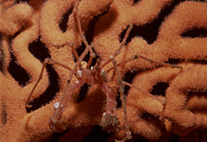Abstract
This study presents a detailed morphological analysis of a new species belonging to the blind trilobite Trimerocephalus McCoy, 1849, T. chopini n. sp., based on exceptionally well preserved articulated specimens from the Late Devonian (Early Famennian) of the Holy Cross Mountains in central Poland. The occurrence of this taxon in Kowala Quarry near Kielce has been reported previously, with specimens often found in single-file queues representing migratory behaviour that was followed by a mass mortality event that preserved these assemblages. The new taxon is compared with other species of Trimerocephalus and is interpreted as being most closely related to a clade consisting of T. caecus, T. lelievrei, T. mimbi, T. shotoriensis and T. tardispinosus.
References
Berkowski, B. (1991) A blind phacopid trilobite from the Famennian of the Holy Cross Mountains. Acta Palaeontologica Polonica, 36, 255–264.
http://dx.doi.org/10.4202/app.2007.0066Berkowski, B. (2002) Famennian Rugosa and Heterocorallia from southern Poland. Palaeontologia Polonica, 61, 3–88.
Crônier, C. (2003) Systematic relationships of the blind phacopine trilobite Trimerocephalus, with a new species from Causseset-Veyran, Montagne Noire. Acta Palaeontologica Polonica, 48, 55–70.
Crônier, C., Bignon, A. & François, A. (2011) Morphological and ontogenetic criteria for defining a trilobite species: the example of Siluro-Devonian Phacopidae. Comptes Rendus Palevol, 10, 143–153.
http://dx.doi.org/10.1016/j.crpv.2010.10.003Crônier, C., Renaud, S., Feist, R. & Auffray, J.C. (1998) Ontogeny of Trimerocephalus lelievrei (Trilobita, Phacopida), a representative of the Late Devonian phacopine paedomorphocline: a morphometric approach. Paleobiology, 24, 359–370.
Feist, R., Yazdi, M. & Becker, T. (2003) Famennian trilobites from the Shotori Range, E-Iran. Annales de la Société Géologique du Nord, Lille: 10, 2ème série, 285–295.
Feist, R., McNamara, K.J., Crônier, C. & Lerosey-Aubril, R. (2009) Patterns of extinction and recovery of phacopid trilobites during the Frasnian-Famennian (Late Devonian) mass extinction event, Canning Basin, Western Australia. Geological Magazine, 146, 12–33.
http://dx.doi.org/10.1017/S0016756808005335Gürich, G. (1896) Das Palaeozoicum im Polnischen Mittelgebirge. Verhandlungen der Russisch−Kaiserlichen Mineralogischen Gesellschaft, 32, 1–539.
Hawle, I. & Corda, A.J.C. (1847) Prodom eine Monographie der böhmischen Trilobiten. Abhandlungen der königlischen böhemischen Gesellschaft der Wissenschaften, 5, 1–176.
Hughes, N.C., Minelli, A. & Fusco, G. (2006) The ontogeny of trilobite segmentation: a comparative approach. Paleobiology, 32, 602–627.
http://dx.doi.org/10.1666/06017.1Kin, A. & Radwański, A. (2008) Trimerocephalus life-position files from the Famennian of Kowala Quarry (Holy Cross Mountains, Central Poland). Polish Academy of Sciences, Institute of Paleobiology, 9th Paleontological Conference, Warszawa, 10–11 October 2008; Abstracts, p. 44.
Lewowicki, S. (1959) Fauna wapieni klimeniowych z Dzikowca Kłodzkiego. Biuletyn Instytutu Geologicznego, 146, 73–113.
Marinovic, B. & Mangel, M. (1999) Krill can shrink as an ecological adaptation to temporarily unfavourable environments. Ecology Letters, 2, 338–343.
McCoy, F. (1849) On the classification of some British fossil Crustacea with notices of new forms in the university collection at Cambridge. Annals and Magazine of Natural History, 2, 392–414.
http://dx.doi.org/10.1080/03745486009494858Osmólska, H. (1958) Famennian Phacopidae from Holy Cross Mts (Poland). Acta Palaeontologica Polonica, 3, 119–148.
http://dx.doi.org/10.4202/app.2007.0066Osmólska, H. (1963) On some Famennian Phacopinae (Trilobita) from the Holy Cross Mountains (Poland). Acta Palaeontologica Polonica, 8, 495–523.
http://dx.doi.org/10.4202/app.2007.0066Pigliucci, M. (2001) Phenotypic Plasticity: Beyond Nature and Nurture. Johns Hopkins University Press, Baltimore, MD, pp. 1–328.
http://dx.doi.org/10.2979/VIC.2001.43.2.328Radwański, A., Kin, A. & Radwańska, U. (2009) Queues of blind phacopid trilobites Trimerocephalus: A case of frozen behaviour of Early Famennian age from the Holy Cross Mountains, Central Poland. Acta Geologica Polonica, 59, 459–481.
Richter, R. (1937) Von Bau und Leben der Trilobiten. 8. Die Salter’sche Einbettung als Folge und Kennzeichen des Häutungs-Vorgangs, Senckenbergiana, 19, 413–431.
Richter, R. (1856) Beitrag zur Paläontologie des Thüringer Waldes. Erster Theil. Denkschriften der kaiserlichen Akademie der Wissenschaften, mathematisch – naturwissenschaftlichen, 11, 87–138.
Speyer, S.E. (1985) Moulting in phacopid trilobites. Transactions of the Royal Society of Edinburgh, 76, 239–259.
http://dx.doi.org/10.1017/S0263593300010476Stillwell, R.C. & Davidowitz, G. (2010) Sex differences in phenotypic plasticity of a mechanism that controls body size: Implications for sexual size dimorphism. Proceedings of the Royal Society of London, B, 277, 3819–3826.
http://dx.doi.org/10.1098/rspb.2010.0895Stillwell, R.C., Blanckenhorn, W.U., Teder, T., Davidowitz, G. & Fox, C.W. (2010) Sex differences in phenotypic plasticity affected variation in sexual size dimorphism in insects: from physiology to evolution. Annual Review of Entomology, 55, 227–245.
http://dx.doi.org/10.1146/annurev-ento-112408-085500Whittington, H.B., Chatterton, B.D.E., Speyer, S.E., Fortey, R.A., Owens, R.M., Chang, W.T., Dean, W.T., Fortey, R.A., Jell, P.A., Laurie, J.R., Palmer, A.R., Repina, L.N., Rushton, A.W.A., Shergold, J.H., Clarkson, E.N.K.,Wilmot, N.V. & Kelly, S.R.A. (1997) Treatise on Invertebrate Paleontology, Part O, Arthropoda 1, Trilobita. Revised. 560 pp. The Geological Society of America and University of Kansas Press, Lawrence.
Wilmer, P., Stone, G. & Johnston, I. (2000) Environmental Physiology of Animals. Blackwell Science, Oxford, pp. 1–754.

